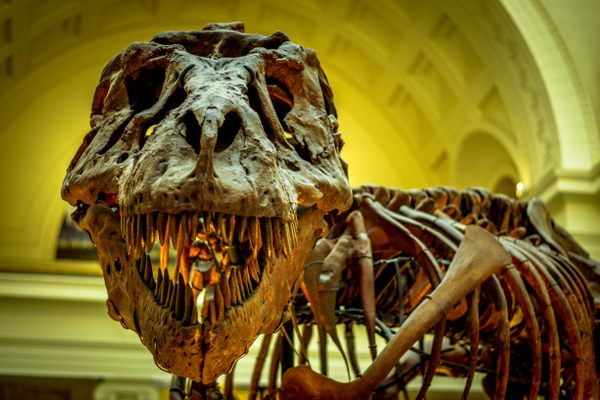Was ‘Dracula’ the Biggest Flying Creature Ever?
In prehistoric Transylvania, a giant darkened the skies.
“It’s just such an awesome image to think about: a giant flying dragon, essentially, coming down and preying on these dinosaurs,” says Ben Thomas, a paleontology graduate student at the University of Portsmouth, England. Earlier this year, Thomas released a video on his paleontology-themed YouTube channel about his visit to the Altmühltal Museum in Denkendorf, Germany. There, he spoke with paleontologist Nizar Ibrahim about one of the museum’s most remarkable specimens. It’s the fragmentary remains of a pterosaur—a flying reptile—that lived in Transylvania, Romania, 66 million years ago, and just might be the largest animal that has ever flown. Scientists have nicknamed it “Dracula.”
The Altmühltal Museum displays a cast of Dracula’s remains, alongside a model skeleton and a life-sized statue of the creature. At an estimated 11.5 feet tall, with a wingspan of 37.4 to 39.4 feet, Dracula was comparable to a giraffe when standing, or a small airplane in flight. “Seeing it on the ground really gives you a proper sense of scale, that these were absolutely terrifying animals if you ever encountered them,” says Thomas. Members of the Azhdarchidae family of pterosaurs, to which Dracula belonged, are famous for their size, but “generally the accepted wingspan for all of the others is about 10 meters [32.8 feet] at most,” says Thomas, making Dracula a giant even among its relatives.

The name Azhdarchidae was coined in 1984 for a specimen from Uzbekistan, from the Persian and Uzbek word for “dragon.” So it’s not surprising that when scientists uncovered the mega-Azhdarchid specimen in Transylvania’s Hațeg (pronounced “Hatzeg”) Basin in 2009, they dubbed it Dracula, which literally means “son of the dragon” (or the Devil) in Romanian. The giant pterosaur is also not the first prehistoric creature named or nicknamed for the famous vampire. In 1975, a dinosaur found in Transylvania was dubbed Bradycneme draculae, meaning “Dracula’s ponderous leg,” for its hefty leg bones. The extra-large vampire bat Desmodus draculae coexisted with early humans in the American tropics, where it may have inspired Indigenous mythology. And two prehistoric arthropods found trapped in Burmese amber bear the species name draculi: a wasp with toothy-looking mouthparts, and a tick that drained the blood of dinosaurs.
We can safely assume that in life, Dracula the pterosaur was at least as scary as its namesake, but there’s still much about it we don’t know. “One of the big issues with the Dracula specimen,” Thomas explains, “is that it’s very, very fragmentary.” Other fossils of big Azhdarchids from the same time and place as Dracula have been excavated, such as the single confirmed species of the genus Hatzegopteryx (which means “Hațeg wing” after the area of discovery). But none of these fossils are from complete skeletons and Dracula’s remains do not overlap with those of Hatzegopteryx, making it difficult to tell for sure if Dracula represents a new species.
Then there’s the question of whether such an enormous creature could actually fly. A 2018 article about Dracula in Scientific American claimed that features of Dracula’s wrist joint “could mean it was not meant for flight.” However, this remains speculation due to how fragmentary Dracula’s remains are. Signage at the Altmühltal Museum indicates to visitors that there is no conclusive evidence ruling out Dracula’s ability to fly, or that of other Azhdarchids. In 2017, Azhdarchid expert and paleoartist Mark Witton told The Guardian that he was certain Hatzegopteryx could achieve “flight speeds that would get a speeding ticket on a U.K. road.” More research is needed, but Thomas agrees: “Maybe [Dracula] was too big to fly—but I don’t think so.”

According to a 2024 paper published in the Journal of Vertebrate Paleontology, many studies have found support for the idea that the largest pterosaurs could fly. “Generally it’s not controversial among pterosaur researchers,” says Thomas. He points to features of Azhdarchid anatomy, “which they would be needing for flight, presumably,” such as partially hollow wing bones to reduce mass, anchor points for strong wing muscles, and other features similar to those found in flying birds today.
Paleontologists studying pterosaurs often use birds or bats for comparison, but it’s become increasingly clear just how unique the flying reptiles were. Instead of walking on their back legs like birds, or hopping awkwardly like bats, it is now believed that pterosaurs folded their wings up to walk on four feet, and could be quite agile on the ground. Some paleontologists theorize that pterosaurs launched themselves into flight from all fours, pushing off with their front limbs, a method not seen in any living creature.

Thomas explains how pterosaur anatomy confirms the theory of “quad-launching.” While birds have enlarged muscles in their wings for flying and in their legs for launching, “with pterosaurs, you have that all sort of contained in one area” in the chest, he says. “It’s essentially a more mass-efficient way of taking off, which is presumably how they got so much bigger than birds.”
The largest Azhdarchids were once thought to be similar to modern soaring birds like seagoing albatrosses or canyon-dwelling condors, both of which are ungainly and slow on the ground. Today, Azhdarchids are often compared with storks, which can fly but spend most of their time on foot, hunting small prey or scavenging. Recent speculative dinosaur documentaries like 2022’s Prehistoric Planet depict Azhdarchids like storks, as leggy opportunists who stroll around snapping up whatever they can get in their long, stabbing beaks, from baby dinosaurs to dinosaur carrion.
With fellow paleontologist Darren Naish, Mark Witton coined the term “terrestrial stalkers” to describe this lifestyle. Flying costs a lot of energy, and many modern birds avoid it until absolutely necessary. A study of pterosaur flight efficiency suggests that as Dracula and its kin adapted to their “terrestrial stalker” niche and grew bigger, they became less-agile flyers, giving up mastery over the skies for the land.

Dracula’s home was one of the most unique environments known to paleontologists. Transylvania’s Hațeg Basin was an island during the Late Cretaceous period some 66 million years ago, at the very end of the age of dinosaurs. There, dinosaurs evolved to be smaller than their mainland relatives due to a lack of space and resources, a phenomenon called “insular dwarfism.” As a result, Thomas explains, some researchers believe that Hațeg Island’s giant, stork-like Azhdarchids, “Hatzegopteryx in particular, would have been the top predator of this ecosystem, preying on dinosaurs…which is pretty spectacular.” Compared with other known Azhdarchids, Hatzegopteryx had an especially muscular neck supporting a large and heavy head and beak, meaning that it might have been able to handle larger prey than its relatives. Did Dracula belong to a species of dinosaur-gobbling Azhdarchid even larger than its cousin Hatzegopteryx? Or was it simply the largest-known individual of an already titanic species?
While Thomas hopes that research on Dracula will be published soon, he points out that there are even more mysteries yet to be uncovered when it comes to the land-stalking dragons of Cretaceous Transylvania. Not long after Dracula was first discovered, another major Azhdarchid fossil was found in Romania from the same time period. While it consists only of one fragment of a lower jaw, “it’s apparently the biggest mandible of a pterosaur ever found,” says Thomas. Based on comparison with other pterosaurs, the jaw may have been more than three and a half feet long when the creature was alive, with features that might differentiate it from Hatzegopteryx. “And so maybe there’s two species coexisting in this environment,” says Thomas.
“But of course,” he adds, “there’s always going to be others out there that haven’t been discovered yet.”



















Follow us on Twitter to get the latest on the world's hidden wonders.
Like us on Facebook to get the latest on the world's hidden wonders.
Follow us on Twitter Like us on Facebook